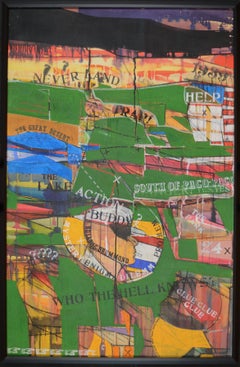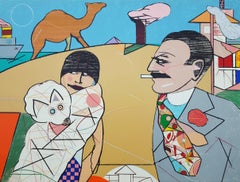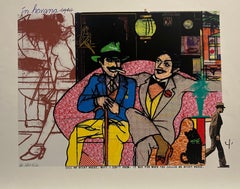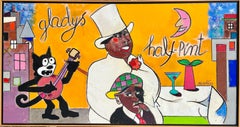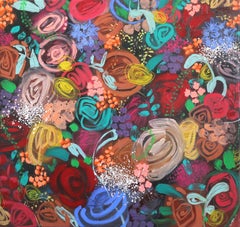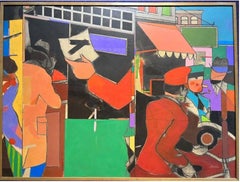Richard Merkin Art
American, 1938-2009
Richard Merkin’s (1938 – September 5, 2009) work conjures up scenes that evoke the raucous spirit of the 1920’s, 30’s and 40’s. In his witty, often eccentric illustrations, Merkin depicts movie stars, jazz musicians, sports heroes and literary impresarios co-mingling with more personal references. In his highly stylized approach to the figure, Merkin privileges color relationships, balance and juxtaposition over strictly literal descriptions of his subjects. And humor; there’s always humor.to
1
6
2
2
Overall Width
to
Overall Height
to
9
1
6
1
1
1
4
2
2
5
5
3
2
1
1
1
1
1
1
1
1
1
1
5
2
1
1
1
10
8,816
2,808
1,655
1,313
1
2
9
Artist: Richard Merkin
Bulldog Drummond and the Great Coca-Cola Mystery by Richard Merkin
By Richard Merkin
Located in Hudson, NY
An iconic mixed media example of Richard Merkin's art.
Bulldog Drummond and the Great Coca-Cola Mystery (1965)
Mixed media on paper
51" x 33"
53" x 35" x 2" framed
Signed "Merkin" ...
Category
1960s Modern Richard Merkin Art
Materials
Paper, Mixed Media
Oedipus and Luxor /// Contemporary Richard Merkin Figurative Funny Screenprint
By Richard Merkin
Located in Saint Augustine, FL
Artist: Richard Merkin (American, 1938-2009)
Title: "Oedipus and Luxor"
*Signed by Merkin in pencil lower right
Circa: 1980
Medium: Original Screenprint on white Arches 88 paper
Limi...
Category
1980s Contemporary Richard Merkin Art
Materials
Screen
Kansas City Monarchs, Lithograph by Richard Merkin
By Richard Merkin
Located in Long Island City, NY
Artist: Richard Merkin, American (1938 - 2009)
Title: Kansas City Monarchs
Year: circa 1977
Medium: Lithograph, signed and numbered in pencil
Edition: 250
Image Size: 18.5 x 26.5 inc...
Category
1970s Contemporary Richard Merkin Art
Materials
Lithograph
In Havana
By Richard Merkin
Located in Toronto, ON
25" x 30" Unframed
Limited Edition Artists Proof
Hand Signed by Richard Merkin
Category
21st Century and Contemporary Richard Merkin Art
Materials
Giclée
$1,200
Large Richard Merkin Painting Harlem Jazz Club, New Yorker Magazine Cover Artist
By Richard Merkin
Located in Surfside, FL
Richard Marshall Merkin (American, 1938-2009)
Gladys and Half-Pint
Hand signed 'Merkin' (center right),
Titled, inscribed, dated, and initialed 'GLADYS BENTLEY AND FRANKIE 'HALF-PINT' JAXON 1997/R.M.' verso.
Oil on canvas
37 1/2 x 72 in. (95.3 x 182.9 cm)
framed 39 1/4 x 74 x 2 in.
Gladys Alberta Bentley (August 12, 1907 – January 18, 1960) was an American blues singer, pianist, and entertainer during the Harlem Renaissance. Her career skyrocketed when she appeared at Harry Hansberry's Clam House, a well-known gay speakeasy in New York in the 1920s, as a black, lesbian, cross-dressing performer. She headlined in the early 1930s at Harlem's Ubangi Club, where she was backed up by a chorus line of drag queens. She dressed in men's clothes (including a signature tailcoat and top hat), played piano, and sang her own raunchy lyrics to popular tunes of the day in a deep, growling voice while flirting with women in the audience. On the decline of the Harlem speakeasies with the repeal of Prohibition, she relocated to southern California, where she was billed as "America's Greatest Sepia Piano Player" and the "Brown Bomber of Sophisticated Songs". She was frequently harassed for wearing men's clothing. She tried to continue her musical career but did not achieve as much success as she had had in the past. Bentley was openly lesbian early in her career, but during the McCarthy Era she started wearing dresses and married, claiming to have been "cured" by taking female hormones.
Frankie "Half-Pint" Jaxon, born Frank Devera Jackson was an African American vaudeville singer, stage designer and comedian, popular in the 1920s and 1930s. He was born in Montgomery, Alabama, orphaned, and raised in Kansas City, Missouri. His nickname of "Half Pint" referred to his 5'2" height. He started in show business around 1910 as a singer in Kansas City, before travelling extensively with medicine shows in Texas, and then touring the eastern seaboard. His feminine voice and outrageous manner, often as a female impersonator, established him as a crowd favorite. By 1917 he had begun working regularly in Atlantic City, New Jersey and in Chicago, often with such performers as Bessie Smith and Ethel Waters, whose staging he helped design.
He served slightly less than a year in the United States Army in 1918–1919 and rose to the rank of sergeant. In the late 1920s he sang with top jazz bands when they passed through Chicago, working with Bennie Moten, King Oliver, Freddie Keppard and others. He performed and recorded with the pianists Cow Cow Davenport, Tampa Red and "Georgia Tom" Dorsey, recording with the latter pair under the name of The Black Hillbillies. He also recorded with the Harlem Hamfats. In the 1930s, he was often on radio in the Chicago area, and led his own band, titled Frankie "Half Pint" Jaxon and His Quarts of Joy. Jaxon appeared with Duke Ellington in a film short titled Black and Tan (1929), and with Bessie Smith in "St. Louis Blues" (1929). Cab Calloway's "Minnie the Moocher" (1931) is based both musically and lyrically on Jaxon's "Willie the Weeper" (1927).
Richard Merkin, Sometimes described as Rhode Island’s most famous New York artist, Richard Merkin has led a dual life for nearly 40 years - teaching at RISD while enjoying a celebrated painting career based in New York City. He has exhibited in countless gallery and museum shows in the US and abroad and is represented in the permanent collections of the Smithsonian Institution, The Museum of Modern Art, the Whitney Museum, the RISD museum and many others. In addition to contributing drawings and paintings to The New Yorker (along with, Art Spiegelman, Saul Steinberg, Harper’s, The New York Times Sunday Magazine and several books on Erotica and Baseball, he is a contributing editor for Vanity Fair and a former style columnist for GQ. Merkin’s honors include a Tiffany Foundation Fellowship and the Rosenthal Foundation Award from the American Academy of Arts and Letters.
Museums and Selected Collections :
The American Federation of Arts, New York, NY
Brooklyn Museum, Brooklyn, NY
Chrysler Museum of Art, Norfolk, VA
First city Bank, Chicago, Ill
Fisk University Art Gallery, Nashville, TN
Hallmark Collections, Kansas City, MO
Massachusetts Institute of Technology, Cambridge, MA
Maimi-Dade Junior College, Miami, FL
Michigan State University, East Lansing, MI
Minnesota Museum of Art, Minneapolis, MN
Museum of Modern Art, New York, NY
Museum of Art, Rhode Island School of Design, RI
McClung Museum, University of Tennessee, Knoxville, TN
Pennsylvania Acadamy of the Arts, Philadelphia PA
Prudential Insurance Company, Boston, Ma
Prudential Insurance Company, Newark, NJ
Rose Art Museum, Brandeis University, Waltham, MA
Sara Robey Foundation, New York, NY
Smithsonian Institution, Washington, DC
State University of Brockport, Brockport, NY
Whitney Museum of American Art, New York, NY
Selected Publications :
1986-Present Contributing Editor, Vanity Fair ..1988-Present, New Yorker... 1988-Present, style column, GQ...1997, Text and Illustration for The Tijuana Bibles, published by Simon & Shuster, 1995, Illustrated book, Leagues Apart: the Men and Times of the Negro Baseball Leagues published by Morrow.
1967 Cover of the Beatles “Sgt. Peppers Lonely Hearts Club Band” Album (Mr. Merkin appears in the back row, right of center)
RISD: MFA in Painting, 1963; Professor, Department of Painting
special skill: Merging his role as flaneur (connoisseur of city life) with his role as painter and social historian, Merkin retrieves lost cultural artifacts – a Turkish cigarette, a gangster, a bowler and generally “things most people don’t know about” – and reconstitutes their Jazz Age virtues on canvas in cubist, comic-laced landscapes of tropical color. (ala Robert Crumb and Ben Katchor)
breaking in: Perpetually on the fly from his middle-class Brooklyn background, Merkin found the perfect escape in the mid ‘60s in George Frazier, a dapper Boston columnist who inspired the emerging New York painter’s overnight reinvention of himself. The elements of structure, stability and surprise he admired in this well-dressed dandy – a cool linen suit, a splash of suspender, a polka dot scarf and pearl-handled walking stick – soon surfaced in paintings peopled by impeccable underdogs of café society along with his personal pop heroes: William Burroughs, Bobby Short and Krazy Kat...
Category
1990s American Modern Richard Merkin Art
Materials
Canvas, Oil Pastel, Oil
Large Richard Merkin Painting Geeks & Gargoyles New Yorker Magazine Cover Artist
By Richard Merkin
Located in Surfside, FL
#9 Geeks and Gargoyles (for Nelson Algren)
Mixed Media and Collage
Provenance:
Obelisk Gallery, Boston, 1967 (label verso)
the word Chicago is featured prominently in this piece.
Sometimes described as Rhode Island’s most famous New York artist, Richard Merkin has led a dual life for nearly 40 years - teaching at RISD while enjoying a celebrated painting career based in New York City. He has exhibited in countless gallery and museum shows in the US and abroad and is represented in the permanent collections of the Smithsonian Institution, The Museum of Modern Art, the Whitney Museum, the RISD museum and many others. In addition to contributing drawings and paintings to The New Yorker (along with, Art Spiegelman, Saul Steinberg, Harper’s, The New York Times Sunday Magazine and several books on Erotica and Baseball, he is a contributing editor for Vanity Fair and a former style columnist for GQ. Merkin’s honors include a Tiffany Foundation Fellowship and the Rosenthal Foundation Award from the American Academy of Arts and Letters.
Museums and Selected Collections :
The American Federation of Arts, New York, NY
Brooklyn Museum, Brooklyn, NY
Chrysler Museum of Art, Norfolk, VA
First city Bank, Chicago, Ill
Fisk University Art Gallery, Nashville, TN
Hallmark Collections, Kansas City, MO
Massachusetts Institute of Technology, Cambridge, MA
Maimi-Dade Junior College, Miami, FL
Michigan State University, East Lansing, MI
Minnesota Museum of Art, Minneapolis, MN
Museum of Modern Art, New York, NY
Museum of Art, Rhode Island School of Design, RI
McClung Museum, University of Tennessee, Knoxville, TN
Pennsylvania Acadamy of the Arts, Philadelphia PA
Prudential Insurance Company, Boston, Ma
Prudential Insurance Company, Newark, NJ
Rose Art Museum, Brandeis University, Waltham, MA
Sara Robey Foundation, New York, NY
Smithsonian Institution, Washington, DC
State University of Brockport, Brockport, NY
Whitney Museum of American Art, New York, NY
Selected Publications :
1986-Present Contributing Editor, Vanity Fair ..1988-Present, New Yorker... 1988-Present, style column, GQ...1997, Text and Illustration for The Tijuana Bibles, published by Simon & Shuster, 1995, Illustrated book, Leagues Apart: the Men and Times of the Negro Baseball Leagues published by Morrow.
1967 Cover of the Beatles “Sgt. Peppers Lonely Hearts Club Band” Album (Mr. Merkin appears in the back row, right of center)
RISD: MFA in Painting, 1963; Professor, Department of Painting
special skill: Merging his role as flaneur (connoisseur of city life) with his role as painter and social historian, Merkin retrieves lost cultural artifacts – a Turkish cigarette, a gangster, a bowler and generally “things most people don’t know about” – and reconstitutes their Jazz Age virtues on canvas in cubist, comic-laced landscapes of tropical color. (ala Robert Crumb and Ben Katchor)
breaking in: Perpetually on the fly from his middle-class Brooklyn background, Merkin found the perfect escape in the mid ‘60s in George Frazier, a dapper Boston columnist who inspired the emerging New York painter’s overnight reinvention of himself. The elements of structure, stability and surprise he admired in this well-dressed dandy – a cool linen suit, a splash of suspender, a polka dot scarf and pearl-handled walking stick – soon surfaced in paintings peopled by impeccable underdogs of café society along with his personal pop heroes: William Burroughs, Bobby Short...
Category
1960s Richard Merkin Art
Materials
Mixed Media
Marilyn Monroe Pop Art 1969 Color Screenprint Richard Merkin
By Richard Merkin
Located in Surfside, FL
Poetry by J.D. REED Artwork by Richard Merkin screenprint in color, 1969, edition 22/50 Published by Bizzaro, Providence, R.I.
Richard Marshall Merkin (1938-2009) was an American painter, illustrator and arts educator. Merkin's fascination with the 1920s and 1930s defined his art and shaped his identity as a professional dandy. Merkin traveled back in time as an artist, to the time of the interwar years, creating narrative scenes (ala Robert Crumb and Ben Katchor) in bright colors of jazz musicians, film stars, writers, and sports heroes. Merkin was as well known for his painting and illustration work as he was for his eccentric collecting habits and his outré fashion sense. he received a Louis Comfort Tiffany Foundation Fellowship in Painting.
Merkin began teaching at the Rhode Island School of Design (RISD) in 1963 and remained there for 42 years, during which time he built his reputation in New York. Some notable students Merkin taught at RISD include Chris Frantz and Tina Weymouth of the band Talking Heads and Martin Mull.
Merkin had been a contributing editor for Vanity Fair since 1986 and a regular contributor of illustrations to The New Yorker since 1988, as well as Harper's and The New York Times' Sunday Magazine. From 1988–1991, he wrote a monthly style column called "Merkin on Style" for Gentlemen's Quarterly.
Merkin also designed several album covers for the Jazz record label Chiaroscuro Records for artists such as Mary Lou Williams, Ruby Braff, and Ellis Larkins.
Merkin's friend, the writer Tom Wolfe wrote in an email to the New York Times upon Merkin's death:
"He was the greatest of that breed, the Artist Dandy, since Sargent, Whistler and Salvador Dali, Like Dali, he had one of the few remaining Great Mustaches in the art world" Perpetually on the fly from his middle-class Brooklyn background, Merkin found the perfect escape in the mid ‘60s in George Frazier, a dapper Boston columnist who inspired the emerging New York painter’s overnight reinvention of himself. The elements of structure, stability and surprise he admired in this well-dressed dandy, a cool linen suit, a splash of suspender, a polka dot scarf and pearl-handled walking stick, soon surfaced in paintings peopled by impeccable underdogs of café society along with his personal pop heroes, William Burroughs, Bobby Short...
Category
1960s Pop Art Richard Merkin Art
Materials
Screen
Stepin Fetchit Pop Art 1969 Color Screenprint Richard Merkin
By Richard Merkin
Located in Surfside, FL
Poetry by J.D. REED Artwork by Richard Merkin screenprint in color, 1969, edition 22/50 Published by Bizzaro, Providence, R.I.
of African American interest for collectors.
Richard Marshall Merkin (1938-2009) was an American painter, illustrator and arts educator. Merkin's fascination with the 1920s and 1930s defined his art and shaped his identity as a professional dandy. Merkin traveled back in time as an artist, to the time of the interwar years, creating narrative scenes (ala Robert Crumb and Ben Katchor) in bright colors of jazz musicians, film stars, writers, and sports heroes. Merkin was as well known for his painting and illustration work as he was for his eccentric collecting habits and his outré fashion sense. he received a Louis Comfort Tiffany Foundation Fellowship in Painting.
Merkin began teaching at the Rhode Island School of Design (RISD) in 1963 and remained there for 42 years, during which time he built his reputation in New York. Some notable students Merkin taught at RISD include Chris Frantz and Tina Weymouth of the band Talking Heads and Martin Mull.
Merkin had been a contributing editor for Vanity Fair since 1986 and a regular contributor of illustrations to The New Yorker since 1988, as well as Harper's and The New York Times' Sunday Magazine. From 1988–1991, he wrote a monthly style column called "Merkin on Style" for Gentlemen's Quarterly.
Merkin also designed several album covers for the Jazz record label Chiaroscuro Records for artists such as Mary Lou Williams, Ruby Braff, and Ellis Larkins.
Merkin's friend, the writer Tom Wolfe wrote in an email to the New York Times upon Merkin's death:
"He was the greatest of that breed, the Artist Dandy, since Sargent, Whistler and Salvador Dali, Like Dali, he had one of the few remaining Great Mustaches in the art world" Perpetually on the fly from his middle-class Brooklyn background, Merkin found the perfect escape in the mid ‘60s in George Frazier, a dapper Boston columnist who inspired the emerging New York painter’s overnight reinvention of himself. The elements of structure, stability and surprise he admired in this well-dressed dandy, a cool linen suit, a splash of suspender, a polka dot scarf and pearl-handled walking stick, soon surfaced in paintings peopled by impeccable underdogs of café society along with his personal pop heroes, William Burroughs, Bobby Short...
Category
1960s Pop Art Richard Merkin Art
Materials
Screen
Prince Valiant Pop Art 1969 Color Screenprint Richard Merkin
By Richard Merkin
Located in Surfside, FL
Poetry by J.D. REED Artwork by Richard Merkin screenprint in color, 1969, edition 22/50 Published by Bizzaro, Providence, R.I.
Richard Marshall Merkin (1938-2009) was an American painter, illustrator and arts educator. Merkin's fascination with the 1920s and 1930s defined his art and shaped his identity as a professional dandy. Merkin traveled back in time as an artist, to the time of the interwar years, creating narrative scenes (ala Robert Crumb and Ben Katchor) in bright colors of jazz musicians, film stars, writers, and sports heroes. Merkin was as well known for his painting and illustration work as he was for his eccentric collecting habits and his outré fashion sense. he received a Louis Comfort Tiffany Foundation Fellowship in Painting.
Merkin began teaching at the Rhode Island School of Design (RISD) in 1963 and remained there for 42 years, during which time he built his reputation in New York. Some notable students Merkin taught at RISD include Chris Frantz and Tina Weymouth of the band Talking Heads and Martin Mull.
Merkin had been a contributing editor for Vanity Fair since 1986 and a regular contributor of illustrations to The New Yorker since 1988, as well as Harper's and The New York Times' Sunday Magazine. From 1988–1991, he wrote a monthly style column called "Merkin on Style" for Gentlemen's Quarterly.
Merkin also designed several album covers for the Jazz record label Chiaroscuro Records for artists such as Mary Lou Williams, Ruby Braff, and Ellis Larkins.
Merkin's friend, the writer Tom Wolfe wrote in an email to the New York Times upon Merkin's death:
"He was the greatest of that breed, the Artist Dandy, since Sargent, Whistler and Salvador Dali, Like Dali, he had one of the few remaining Great Mustaches in the art world" Perpetually on the fly from his middle-class Brooklyn background, Merkin found the perfect escape in the mid ‘60s in George Frazier, a dapper Boston columnist who inspired the emerging New York painter’s overnight reinvention of himself. The elements of structure, stability and surprise he admired in this well-dressed dandy, a cool linen suit, a splash of suspender, a polka dot scarf and pearl-handled walking stick, soon surfaced in paintings peopled by impeccable underdogs of café society along with his personal pop heroes, William Burroughs, Bobby Short...
Category
1960s Pop Art Richard Merkin Art
Materials
Screen
Epitaph/Tombstone jack Armstrong Pop Art 1969 Color Screenprint Richard Merkin
By Richard Merkin
Located in Surfside, FL
Poetry by J.D. REED Artwork by Richard Merkin screenprint in color, 1969, edition 22/50 Published by Bizzaro, Providence, R.I.
Richard Marshall Merkin (1938-2009) was an American painter, illustrator and arts educator. Merkin's fascination with the 1920s and 1930s defined his art and shaped his identity as a professional dandy. Merkin traveled back in time as an artist, to the time of the interwar years, creating narrative scenes (ala Robert Crumb and Ben Katchor) in bright colors of jazz musicians, film stars, writers, and sports heroes. Merkin was as well known for his painting and illustration work as he was for his eccentric collecting habits and his outré fashion sense. he received a Louis Comfort Tiffany Foundation Fellowship in Painting.
Merkin began teaching at the Rhode Island School of Design (RISD) in 1963 and remained there for 42 years, during which time he built his reputation in New York. Some notable students Merkin taught at RISD include Chris Frantz and Tina Weymouth of the band Talking Heads and Martin Mull.
Merkin had been a contributing editor for Vanity Fair since 1986 and a regular contributor of illustrations to The New Yorker since 1988, as well as Harper's and The New York Times' Sunday Magazine. From 1988–1991, he wrote a monthly style column called "Merkin on Style" for Gentlemen's Quarterly.
Merkin also designed several album covers for the Jazz record label Chiaroscuro Records for artists such as Mary Lou Williams, Ruby Braff, and Ellis Larkins.
Merkin's friend, the writer Tom Wolfe wrote in an email to the New York Times upon Merkin's death:
"He was the greatest of that breed, the Artist Dandy, since Sargent, Whistler and Salvador Dali, Like Dali, he had one of the few remaining Great Mustaches in the art world" Perpetually on the fly from his middle-class Brooklyn background, Merkin found the perfect escape in the mid ‘60s in George Frazier, a dapper Boston columnist who inspired the emerging New York painter’s overnight reinvention of himself. The elements of structure, stability and surprise he admired in this well-dressed dandy, a cool linen suit, a splash of suspender, a polka dot scarf and pearl-handled walking stick, soon surfaced in paintings peopled by impeccable underdogs of café society along with his personal pop heroes, William Burroughs, Bobby Short...
Category
1960s Pop Art Richard Merkin Art
Materials
Screen
Related Items
Été souverain
By Corneille
Located in Malmo, SE
Publisher GKM.
Unframed.
Edition of 150 ex.
Paper: 300gr. Goya.
Signed, dated and numbered.
Free shipment worldwide.
Corneille, one of the founders of the COBRA group, has passed aw...
Category
1980s Contemporary Richard Merkin Art
Materials
Screen
Bloom I - Floral Flower Abstract Mixed Media Oversized Artwork
By Sally K
Located in Los Angeles, CA
Gazing at Lebanese American artist Sally K.'s floral artworks is consuming and empowering. Inspired by the endless variety of beautiful flowers, she creates pop-realistic paintings t...
Category
21st Century and Contemporary Modern Richard Merkin Art
Materials
Canvas, Acrylic, Oil Pastel
A Seat at the Table by Gee Gee Collins Figurative Contemporary painting
By Gee Gee Collins
Located in Atlanta, GA
A vibrant and expressive figurative work by Gee Gee Collins, A Seat at the Table showcases a boldly abstracted female form in rich hues of cobalt blue, coral, and ivory. Executed in ...
Category
2010s Contemporary Richard Merkin Art
Materials
Paper, Mixed Media
$1,400
H 27.5 in W 21.5 in D 0.5 in
Album No 6 (I)
By Vladimir Velickovic
Located in Malmo, SE
Publisher GKM.
Unframed.
Edition of 150 ex.
Signed, dated and numbered.
Free shipment worldwide.
Vladimir Velickovic was born in 1935 in Belgrade.
He graduated from the Faculty of ...
Category
1990s Contemporary Richard Merkin Art
Materials
Lithograph
Mid Century Yellow and Blue Large Scale Abstract
By Louis Earnest Nadalini
Located in Soquel, CA
Stunning and expressive large scale oil painting by mid-century San Francisco artist Louis Earnest Nadalini (American, 1927-1995). Signed "Nadalini" lower right. Unframed. Image size...
Category
1950s American Modern Richard Merkin Art
Materials
Canvas, Oil, Wood Panel
$3,500
H 64 in W 48 in D 1 in
All this is vital importance II
By Yrjö Edelmann
Located in Malmo, SE
Publisher GKM.
Unframed.
Edition of 150 ex.
Signed by the artist.
Free shipment worldwide.
Reality or fantasy? What is the difference between fantasy and fact, between night and da...
Category
2010s Contemporary Richard Merkin Art
Materials
Giclée
"Personage" Heavy Impasto Expressionist Portrait of Lady with a Hat
Located in Soquel, CA
"Personage" Heavy Impasto Expressionist Portrait of Lady with a Hat
Abstract expressionist portrait of a woman wearing a hat by California artist Harald "Harry" Dry Schmidt (America...
Category
1970s American Modern Richard Merkin Art
Materials
Canvas, Oil, Stretcher Bars
$2,150
H 21 in W 20 in D 1 in
Repetitive sensations of Yves Klein Blue II
By Yrjö Edelmann
Located in Malmo, SE
The final print
Shortly before his sudden and
very sad passing in March this year,
Yrjö Edelmann made this beautiful print,
Repetitive sensations of Yves Klein Blue...
Category
2010s Contemporary Richard Merkin Art
Materials
Giclée
Super Silver Oscar (Limited Edition Print)
By Mauro Oliveira
Located in LOS ANGELES, CA
**ANNUAL SUPER SALE UNTIL APRIL 15TH ONLY**
*This Price Won't Be Repeated Again This Year-Take Advantage Of It*
Celebrating the Academy in this original and limited Os...
Category
21st Century and Contemporary Pop Art Richard Merkin Art
Materials
Giclée
$796 Sale Price
20% Off
H 80 in W 34 in D 0.1 in
Contemporary figurative abstract expressive oil painting of woman on canvas
Located in VÉNISSIEUX, FR
This contemporary, expressive figurative oil painting titled No Limits was created by French artist Natalya Mougenot and marks a significant shift in her artistic journey. Part of he...
Category
2010s Abstract Expressionist Richard Merkin Art
Materials
Canvas, Oil, Oil Pastel, Acrylic
$901 Sale Price
20% Off
H 27.56 in W 19.69 in D 0.79 in
Tony Fitzpatrick 'Hand of Ishmael' Signed Aquatint Etching, Framed, 2007
By Tony Fitzpatrick
Located in Denver, CO
Hand of Ishmael is a striking original aquatint etching with Chine-collé by renowned American artist Tony Fitzpatrick (b. 1958). This richly detailed print showcases a vividly illust...
Category
Late 20th Century Surrealist Richard Merkin Art
Materials
Mixed Media, Aquatint
$2,450 Sale Price
30% Off
H 29.5 in W 23.5 in D 0.75 in
No Signal - Colorful and textured painting of Woman in Los Angeles
Located in Dallas, TX
Packed with colour and texture, "No Signal", by British contemporary artist Dan Parry-Jones captures a fleeting urban moment with cinematic intensity. A solitary woman walks through ...
Category
2010s Contemporary Richard Merkin Art
Materials
Mixed Media, Acrylic, Board
$5,800
H 41.34 in W 41.34 in D 1.58 in
Previously Available Items
Just for Laughs, by Richard Merkin
By Richard Merkin
Located in Long Island City, NY
Just For Laughs You're With Me Night and Day by Richard Merkin, American (1938–2009)
Screenprint, signed and numbered in pencil
Edition of 62/250
Image Size: 18 x 24.25 inches
Size: ...
Category
1970s Contemporary Richard Merkin Art
Materials
Screen
Escape of Tony Biddle
By Richard Merkin
Located in Los Angeles, CA
RICHARD MERKIN
"THE ESCAPE OF TONY BIDDLE"
OIL ON CANVAS, SIGNED
AMERICAN, DATED 1982
PROVENANCE: TERRY DINTENFASS GALLERY, NEW YORK
36 X 48 INCHES
Richard Merkin
1938-2009
Richard Merkin’s work conjures up scenes that evoke the raucous spirit of the 1920’s, 30’s and 40’s. In his witty, often eccentric illustrations and paintings, Merkin depicts movie stars, jazz musicians, sports heroes and literary impresarios co-mingling with more personal references. In his highly stylized approach to the figure, Merkin privileges color relationships, balance and juxtaposition over strictly literal descriptions of his subjects.
Merging his role as flaneur (connoisseur of city life) with his role as painter and social historian, Merkin retrieves lost cultural artifacts-a Turkish cigarette, a gangster, a bowler and generally 'things most people don't know about'-and reconstitutes their Jazz Age virtues on canvas in cubist, comic-laced landscapes of tropical color.
“This desire to know and celebrate people and events that others find devoid of significance”, according to Barbara Dayer Gallati, ” is a primary characteristic of Merkin’s art and the source of the irony that prevails within it. More often than not these esoteric fragments of “public” information reveal a taste for the bizarre or darker side of human existence, the sinister nature of which is relieved by the artist’s use of vibrant color and dynamic compositions.”
In agreement, Tom Wolfe writes, "The typical Merkin picture takes legendary American images-from baseball, the movies, fashion, Society, tabloid crime and scandal-and mixes them with his own autobiography, often with dream-">Richard Merkin was born in Brooklyn, New York in 1938, and held degrees from Syracuse University and the Rhode Island School of Design. In 1962-63 he received a Louis Comfort Tiffany Foundation Fellowship in Painting and, in 1975, The Richard and Hinda Rosenthal Foundation Award from The National Institute of Arts and Letters.
Merkin also has the dubious distinction of appearing on the cover of the Beatles’ Sgt. Pepper’s Lonely Hearts Club Band album, (back row, right of center).
Merkin began teaching at the Rhode Island School of Design (RISD) in 1963 and remained there for nearly 42 years. During this time, he built his reputation as a fine artist in New York City. He is represented in the permanent collections of The Museum of Modern Art, The Smithsonian Institution and the Whitney Museum as well as many others. Mr. Merkin had been a Contributing Editor for Vanity Fair from 1986 to 2008 and a regular contributor of illustrations to The New Yorker since 1988, as well as Harper’s and The New York Time’s Sunday Magazine. From 1988-1991 he wrote a monthly ">Merkin’s exhibitions in Hudson, NY began in 2000 at Kendall Art & Design, a gallery run by one of his former RISD students, Laura Battle...
Category
1980s Pop Art Richard Merkin Art
Materials
Canvas, Oil
Cincinnati Underworld
By Richard Merkin
Located in Long Island City, NY
Artist: Richard Merkin, American (1938 - 2009)
Title: Cincinnati Underworld
Year: circa 1970
Medium: Silkscreen, Signed and numbered in pencil
Edition: 170/250
Size: 20 in. x 16 in. ...
Category
1970s Contemporary Richard Merkin Art
Materials
Screen
New Yorker Illustration Graffiti Artist Jean Michel Basquiat Portrait Pop Art
By Richard Merkin
Located in Surfside, FL
"The Graffiti Artist", Published in the New Yorker Magazine, 1985 Pastel and oil stick on paper Modernist portrait of Jean-Michel Basquiat. Comes with exhibition catalog in which it ...
Category
Late 20th Century Pop Art Richard Merkin Art
Materials
Paper, Oil Crayon, Oil Pastel
Klaus Kinski and Claudia Cardinale in Fitzcarraldo
By Richard Merkin
Located in Hudson, NY
Fitzcarraldo (1982) is a film written and directed by Werner Herzog starring Klaus Kinski and Claudia Cardinale. It portrays the real-life would-be rubbe...
Category
1980s Contemporary Richard Merkin Art
Materials
Paper, Oil Pastel
These Foolish Things Remind Me of You Pop Art Color Screenprint Richard Merkin
By Richard Merkin
Located in Surfside, FL
A cigarette that bears a lipstick's traces, An airline ticket to romantic places, Lyrics from these foolish things (covered by Frank Sinatra, Nat King Cole and Billie Holiday) This i...
Category
Late 20th Century Pop Art Richard Merkin Art
Materials
Screen
Just for Laughs, Night and Day Pop Art Color Screenprint Richard Merkin
By Richard Merkin
Located in Surfside, FL
This is an original vintage signed silkscreen screenprint. edition of 250 signed and numbered.
Richard Marshall Merkin (1938-2009) was an American painter, illustrator and arts educa...
Category
Late 20th Century Pop Art Richard Merkin Art
Materials
Screen
Art and perfume Tuxedo Pop Art Color Screenprint Richard Merkin
By Richard Merkin
Located in Surfside, FL
This is an original vintage unsigned screenprint. from the publisher. Every Day is D-Day Under the El, with a collage of ol potos of Paris France.
Richard Marshall Merkin (1938-2009)...
Category
1960s Pop Art Richard Merkin Art
Materials
Screen
Lash LaRue Pop Art 1969 Color Screenprint Richard Merkin
By Richard Merkin
Located in Surfside, FL
Poetry by J.D. REED Artwork by Richard Merkin screenprint in color, 1969, edition 22/50 Published by Bizzaro, Providence, R.I.
Richard Marshall Merkin (1938-2009) was an American ...
Category
1960s Pop Art Richard Merkin Art
Materials
Screen
Stepin Fetchit Pop Art 1969 Color Screenprint Richard Merkin
By Richard Merkin
Located in Surfside, FL
Poetry by J.D. REED Artwork by Richard Merkin screenprint in color, 1969, edition 22/50 Published by Bizzaro, Providence, R.I.
of African American interest for collectors.
Richard ...
Category
1960s Pop Art Richard Merkin Art
Materials
Screen
Marilyn Monroe Pop Art 1969 Color Screenprint Richard Merkin
By Richard Merkin
Located in Surfside, FL
Poetry by J.D. REED Artwork by Richard Merkin screenprint in color, 1969, edition 22/50 Published by Bizzaro, Providence, R.I.
Richard Marshall Merkin (1938-2009) was an American painter, illustrator and arts educator. Merkin's fascination with the 1920s and 1930s defined his art and shaped his identity as a professional dandy. Merkin traveled back in time as an artist, to the time of the interwar years, creating narrative scenes (ala Robert Crumb and Ben Katchor) in bright colors of jazz musicians, film stars, writers, and sports heroes. Merkin was as well known for his painting and illustration work as he was for his eccentric collecting habits and his outré fashion sense. he received a Louis Comfort Tiffany Foundation Fellowship in Painting.
Merkin began teaching at the Rhode Island School of Design (RISD) in 1963 and remained there for 42 years, during which time he built his reputation in New York. Some notable students Merkin taught at RISD include Chris Frantz and Tina Weymouth...
Category
1960s Pop Art Richard Merkin Art
Materials
Screen
Prince Valiant Pop Art 1969 Color Screenprint Richard Merkin
By Richard Merkin
Located in Surfside, FL
Poetry by J.D. REED Artwork by Richard Merkin screenprint in color, 1969, edition 22/50 Published by Bizzaro, Providence, R.I.
Richard Marshall Merkin (1938-2009) was an American p...
Category
1960s Pop Art Richard Merkin Art
Materials
Screen
Richard Merkin art for sale on 1stDibs.
Find a wide variety of authentic Richard Merkin art available for sale on 1stDibs. If you’re browsing the collection of art to introduce a pop of color in a neutral corner of your living room or bedroom, you can find work that includes elements of blue and other colors. You can also browse by medium to find art by Richard Merkin in screen print, canvas, crayon and more. Much of the original work by this artist or collective was created during the 20th century and is mostly associated with the Pop Art style. Not every interior allows for large Richard Merkin art, so small editions measuring 20 inches across are available. Customers who are interested in this artist might also find the work of Richard Bernstein, Brian Rice, and CLAYTON POND. Richard Merkin art prices can differ depending upon medium, time period and other attributes. On 1stDibs, the price for these items starts at $700 and tops out at $12,000, while the average work can sell for $750.
